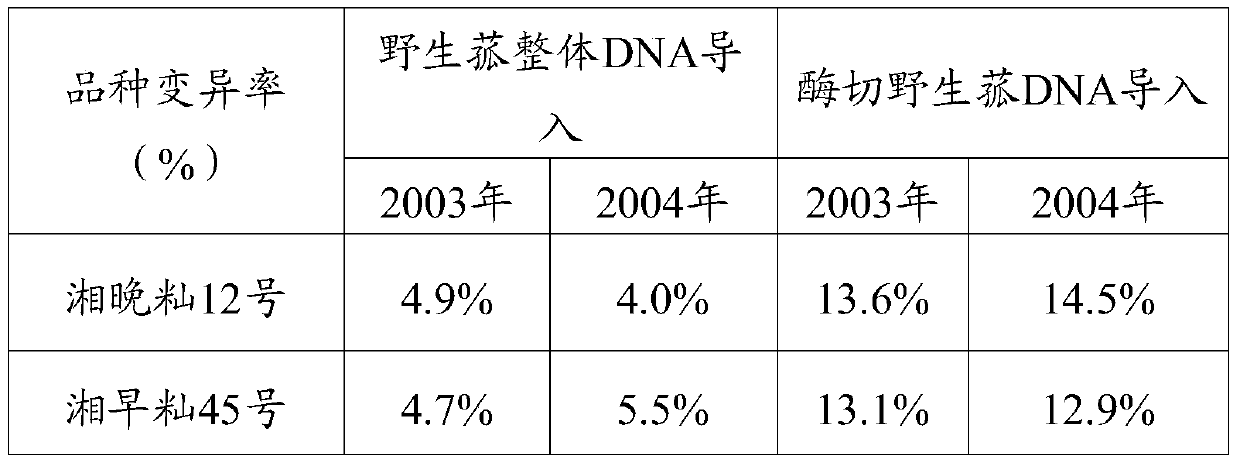A kind of rice breeding method
A technology of rice and pollen tube channeling, applied to other methods of inserting foreign genetic materials, botanical equipment and methods, angiosperms/flowering plants, etc., can solve the problems of crazy segregation of hybrid offspring, difficulty in obtaining stable offspring, etc. , to achieve the effects of large spikes, multiple grains, increased variation rate, and thick stems
- Summary
- Abstract
- Description
- Claims
- Application Information
AI Technical Summary
Problems solved by technology
Method used
Image
Examples
Embodiment 1
[0044] Example 1 Extraction of DNA from wild wild mushroom
[0045]1. Take 50 grams of young wild wild rice leaves, grind with liquid nitrogen, add 50ml 2 times CTAB extraction buffer, mix well in a 500ml centrifuge tube, then add 50ml 1 times CTAB extraction buffer. Among them, 2 times CTAB extraction buffer includes: 2% CTAB (cetyltrimethylammonium bromide), 100mM Tris (trishydroxymethylaminomethane), 20mM EDTA (disodium ethylenediaminetetraacetic acid pH8.0) , 1.4M NaCl, 1% PVP (polyvinylpyrrolidone) Mw40,000; 1 times CTAB buffer (2 times CTAB extraction buffer diluted 1 times with double distilled water).
[0046] 2. In the constant bath at 55-65°C for 30 minutes, add 150ml of chloroform:isoamyl alcohol (24:1), fully shake for 5 minutes, 8000r / min, and centrifuge at room temperature for 5 minutes.
[0047] 3. Take the supernatant and add 1 / 10 volume of 10% CTAB buffer solution, add 200ml chloroform:isoamyl alcohol (24:1), fully shake for 5min, 4000r / min, and centrifuge at...
Embodiment 2
[0053] Example 2 Introduction of wild wild mushroom DNA and selection of offspring
[0054] 1. Selection of Imported Receptors
[0055] Recipients should choose varieties or strains with good comprehensive traits and only a few or individual traits that need to be improved.
[0056] 2. Import time and method
[0057] After 1-3 hours of rice flowering, cut 1 / 3-2 / 3 of the stigma, and then drip DNA solution at the incision with a concentration of 100-200 μg / ml. Soak and remove the ovary of the stigma, and bag it in time. Harvest when the seeds are ripe 0 generation seeds.
[0058] 3. Analysis of the mutation rate of wild wild wild rice whole DNA and enzyme-cleaved wild wild rice DNA into rice
[0059] Using the method of step 2, the wild wild rice wild rice whole DNA obtained in step 7 of Example 1 and the restriction wild wild rice wild rice DNA obtained in step 8 were respectively introduced into rice varieties Xiangwanxian 12 and Xiangzaoxian 45.
[0060] In 2003, using ...
Embodiment 3
[0074] Jiang Xiang Zao Xian 45 D 5 The stable strains obtained from the previous generation were sown on April 1 and matured on July 18, belonging to the type of mid-maturing early rice.
[0075] The results of field sampling and seed testing show that the average effective panicle per stalk is 9.85 panicles, the number of effective panicles per mu is 166,650, the number of solid grains per panicle is 149.9 grains, the seed setting rate is 74.8%, and the thousand-grain weight is 25.4 grams, which is equivalent to 625 kg per mu. The actual yield per mu 627 kg.
[0076] There are 276,700 effective panicles per mu of direct seeding, the number of solid grains per panicle is 100.46, and the seed setting rate is 72.04%. The theoretical yield is 706.05 kg per mu based on the calculation of 1,000-grain weight of 25.4 grams.
[0077] The wild rice wild rice DNA is introduced into the innovative new rice variety with thick stems, large spikes and many grains, and fast filling speed in...
PUM
 Login to View More
Login to View More Abstract
Description
Claims
Application Information
 Login to View More
Login to View More - R&D
- Intellectual Property
- Life Sciences
- Materials
- Tech Scout
- Unparalleled Data Quality
- Higher Quality Content
- 60% Fewer Hallucinations
Browse by: Latest US Patents, China's latest patents, Technical Efficacy Thesaurus, Application Domain, Technology Topic, Popular Technical Reports.
© 2025 PatSnap. All rights reserved.Legal|Privacy policy|Modern Slavery Act Transparency Statement|Sitemap|About US| Contact US: help@patsnap.com

